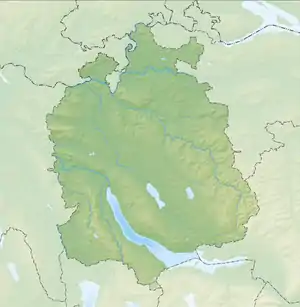Hedingen | |
|---|---|
 | |
 Coat of arms | |
Location of Hedingen | |
 Hedingen  Hedingen | |
| Coordinates: 47°18′N 8°27′E / 47.300°N 8.450°E | |
| Country | Switzerland |
| Canton | Zurich |
| District | Affoltern |
| Area | |
| • Total | 6.59 km2 (2.54 sq mi) |
| Elevation | 501 m (1,644 ft) |
| Population (31 December 2018)[2] | |
| • Total | 3,734 |
| • Density | 570/km2 (1,500/sq mi) |
| Time zone | UTC+01:00 (Central European Time) |
| • Summer (DST) | UTC+02:00 (Central European Summer Time) |
| Postal code(s) | 8908 |
| SFOS number | 0005 |
| Surrounded by | Affoltern am Albis, Arni (AG), Bonstetten, Islisberg (AG), Jonen (AG), Stallikon |
| Website | www SFSO statistics |
Hedingen is a municipality in the district of Affoltern in the canton of Zürich in Switzerland.
History
Hedingen is first mentioned in 1116 as Hedingen.[3]
Geography


Hedingen has an area of 6.6 km2 (2.5 sq mi). Of this area, 48% is used for agricultural purposes, while 32.6% is forested. Of the rest of the land, 18.6% is settled (buildings or roads) and the remainder (0.8%) is non-productive (rivers, glaciers or mountains).[4]
The municipality includes the village of Hedingen, the hamlets of Fromoos and Ismatt and scattered houses.
Demographics
Hedingen has a population (as of 31 December 2020) of 3,795.[5] As of 2007, 13.5% of the population was made up of foreign nationals. Over the last 10 years the population has grown at a rate of 18.2%. Most of the population (as of 2000) speaks German (88.7%), with Italian being second most common ( 3.0%) and Serbo-Croatian being third ( 2.0%).
In the 2007 election the most popular party was the SVP which received 34% of the vote. The next three most popular parties were the SPS (19.4%), the FDP (13.8%) and the CSP (11.8%).
The age distribution of the population (as of 2000) is children and teenagers (0–19 years old) make up 28.1% of the population, while adults (20–64 years old) make up 60.9% and seniors (over 64 years old) make up 11%. In Hedingen about 83% of the population (between age 25-64) have completed either non-mandatory upper secondary education or additional higher education (either university or a Fachhochschule).
Hedingen has an unemployment rate of 1.59%. As of 2005, there were 43 people employed in the primary economic sector and about 16 businesses involved in this sector. 712 people are employed in the secondary sector and there are 24 businesses in this sector. 547 people are employed in the tertiary sector, with 78 businesses in this sector.[4] The historical population is given in the following table:[3]
| year | population |
|---|---|
| 1467 | 24 households |
| 1634 | 448 |
| 1689 | 689 |
| 1850 | 992 |
| 1888 | 807 |
| 1900 | 849 |
| 1950 | 1,138 |
| 1960 | 1,840 |
| 1990 | 2,190 |
| 2000 | 2,991 |
| 2004 | 3,107 |
| 2007 | 3,318 |
| 2011 | 3,464 |
| 2013 | 3,585 |
Transport
Hedingen railway station is a stop of the Zürich S-Bahn on the lines S5 and S14. Its train station is a 27 minute ride from Zürich Hauptbahnhof.
References
- ↑ "Arealstatistik Standard - Gemeinden nach 4 Hauptbereichen". Federal Statistical Office. Retrieved 13 January 2019.
- ↑ "Ständige Wohnbevölkerung nach Staatsangehörigkeitskategorie Geschlecht und Gemeinde; Provisorische Jahresergebnisse; 2018". Federal Statistical Office. 9 April 2019. Retrieved 11 April 2019.
- 1 2 Hedingen in German, French and Italian in the online Historical Dictionary of Switzerland.
- 1 2 Swiss Federal Statistical Office Archived 2016-01-05 at the Wayback Machine accessed 22-Jul-2009
- ↑ "Ständige und nichtständige Wohnbevölkerung nach institutionellen Gliederungen, Geburtsort und Staatsangehörigkeit". bfs.admin.ch (in German). Swiss Federal Statistical Office - STAT-TAB. 31 December 2020. Retrieved 21 September 2021.
External links
- Official website (in German)
- Hedingen in German, French and Italian in the online Historical Dictionary of Switzerland.